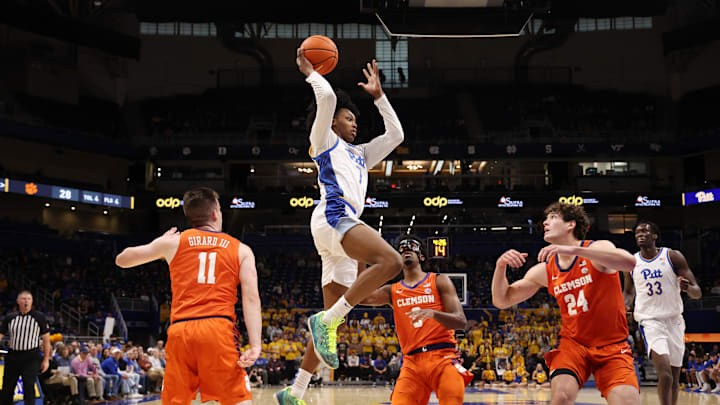The Cleveland Cavaliers will have full control of their 2024 NBA draft pick, a luxury they will not have again until 2030.
With that in mind, the next NBA Draft will be crucial for the Cavaliers to get right. The team has a relatively good recent history in the draft, but they will not have an opportunity to atone for a poor selection entirely for the rest of the decade. Needless to say, the pressure is on for Cleveland's scouting department.
Not only do the Cavs lack any real draft capital for the next six years, they are already facing a tough battle this season. With their most recent disheartening injury news for Darius Garland and Evan Mobley, the Cavaliers may enter the 2024 NBA Draft with a higher selection than initially expected at the start of the year. Before the injuries, Cleveland could not consistently produce, already leaving them in the lower end of playoff contenders in the Eastern Conference.
In last year's draft, the Cavs did not have a first-round pick, drafting former top prospect Emoni Bates at 49th overall. Later, they signed breakout guard Craig Porter Jr. from Wichita State as an undrafted rookie. While Bates has not stepped on the court for the Cavaliers too often this year, his performance in the G-League hints at a bright future for the young forward in the NBA. Porter has already solidified himself as a fan favorite, too, adding a surge of energy and scoring output for the Cavs in the midst of their injury woes and messy offense.
A few days before the news, Bleacher Report's Jonathan Wasserman published a full 2024 NBA mock draft, placing the Cavaliers just out the lottery at 16th overall. Surprisingly, their proposed choice is another backcourt player rather than a wing or big man. Wasserman suggested the Cavs should target Pittsburgh Panther Carlton Carrington, a 6-foot 5 point guard who has begun falling in draft stock over the past few weeks.
Carrington is praised for his playmaking and creative shot-making abilities, but his inefficient scoring and defensive shortcomings have scouts raising some suspicions to his long-term viability as an NBA talent.
Over 11 games played, Carrington is averaging 14 points, 5.7 assists and 5.3 rebounds with a 33.8 percent 3-point shot thus far. Carrington's highlight of the year came in the season opener with a triple-double, scoring 18 points alongside 12 rebound and 10 assists. He shot 4-of-7 from deep and forced defenders to overcommit to him, allowing the freshman chances to dish it out to an open shooter.
Since then, he has yet to notch another game with double digit rebounds or assists, though his scoring has remained fairly reliable, even if it can be inconsistent at times.
Does Carrington make sense for the Cleveland Cavaliers backcourt rotation?
Currently, Cleveland's starting backcourt (when healthy) consists of Darius Garland and Donovan Mitchell, two undersized but talented guards. Off the bench, Caris LeVert has served as the first reserve option. The Cavs also have Ricky Rubio and Ty Jerome on guaranteed contracts as backup point guards, but neither player's future with Cleveland is absolutely certain at this point.
Additionally, LeVert typically serves as a wing rather than a facilitator, leaving room for an offensive initiator such as Carrington to make a difference. Carrington's primary opposition as a second unit point guard is the aforementioned Craig Porter Jr.
Porter is currently on a two-way deal with the Cavs, though he could eventually be signed to the team's 15th and final roster spot before the end of the season. In that case, Carrington's role with Cleveland becomes much less obvious. His current defensive woes also raise eyebrows, as the Cavs' starting backcourt is already far from defensively dominant.
Ideally, the Cavaliers would add another forward or center that can add floor spacing, similar to their hopes for Bates' future role. Looking at the rest of Wasserman's list, there is no undeniably perfect prospect for the Cavs to target. Tennessee forward Dalton Knecht has connected on over 40 percent of his 3-point attempts, but his overall value in the NBA remains in question.
Second, Bobi Klintman from Wake Forest is ranked 22nd overall but could see his stock rise as a 6-foot-8 versatile forward by the time the draft arrives. Either player would be in competition with Emoni Bates, but the past few years have taught Cleveland nothing if not that they should never feel as though they have too many choices at their forward positions.
Carrington could be the best choice available if the Cavaliers end up in the mid-to-high teens for their selection, but they should undoubtedly keep their eyes on other possible steals. As with any draft, though, the player the Cavaliers ultimately select may end up nothing more than a piece of an offseason trade to acquire win-now pieces. If the Cavs plan to trade their selection, the prospect's fit in Cleveland is not the question; instead, the focus is on what other team is interested.
The Cavaliers' last first-round pick, Ochai Agbaji, was eventually dealt to the Utah Jazz in the Donovan Mitchell trade. The Cavs cannot trade their 2024 first-round pick until after they make the selection due to the Stepien Rule, but this season's final result may sway the Cavaliers to package another young asset for a proven player.
